Long-lasting LTP requires neither repeated trains for its induction nor protein synthesis for its development
- PMID: 22792408
- PMCID: PMC3394721
- DOI: 10.1371/journal.pone.0040823
Long-lasting LTP requires neither repeated trains for its induction nor protein synthesis for its development
Abstract
Current thinking about LTP triggered in the area CA1 of hippocampal slices is ruled by two "dogmas": (1) A single train of high-frequency stimulation is sufficient to trigger short-lasting LTP (1-3 h), whereas multiple trains are required to induce long-lasting LTP (L-LTP, more than 4 h). (2) The development of the late phase of L-LTP requires the synthesis of new proteins. In this study, we found that a single high-frequency train could trigger an LTP lasting more than 8 h that was not affected by either anisomycin or cycloheximide (two inhibitors of protein synthesis). We ascertained that the induction of this L-LTP made use of the same mechanisms as those usually reported to be involved in LTP induction: it was dependent on NMDA receptors and on the activation of two "core" kinases, CaMKII and PI3K. These findings call into question the two "dogmas" about LTP.
Conflict of interest statement
Figures
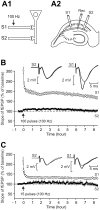

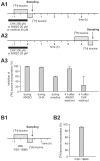
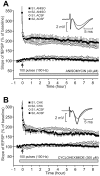
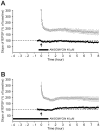


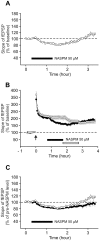

Similar articles
-
Phosphatidylinositol 3-kinase regulates the induction of long-term potentiation through extracellular signal-related kinase-independent mechanisms.J Neurosci. 2003 May 1;23(9):3679-88. doi: 10.1523/JNEUROSCI.23-09-03679.2003. J Neurosci. 2003. PMID: 12736339 Free PMC article.
-
Ca(2+) permeable AMPA receptor induced long-term potentiation requires PI3/MAP kinases but not Ca/CaM-dependent kinase II.PLoS One. 2009;4(2):e4339. doi: 10.1371/journal.pone.0004339. Epub 2009 Feb 3. PLoS One. 2009. PMID: 19190753 Free PMC article.
-
Cooperation of taurine uptake and dopamine D1 receptor activation facilitates the induction of protein synthesis-dependent late LTP.Neuropharmacology. 2014 Apr;79:101-11. doi: 10.1016/j.neuropharm.2013.10.035. Epub 2013 Nov 10. Neuropharmacology. 2014. PMID: 24225198
-
Mechanisms of CaMKII action in long-term potentiation.Nat Rev Neurosci. 2012 Feb 15;13(3):169-82. doi: 10.1038/nrn3192. Nat Rev Neurosci. 2012. PMID: 22334212 Free PMC article. Review.
-
Distinct roles of multiple isoforms of CaMKII in signaling to the nucleus.Biochim Biophys Acta. 2015 Sep;1853(9):1953-7. doi: 10.1016/j.bbamcr.2015.02.008. Epub 2015 Feb 17. Biochim Biophys Acta. 2015. PMID: 25700840 Free PMC article. Review.
Cited by
-
Paradoxical LTP maintenance with inhibition of protein synthesis and the proteasome suggests a novel protein synthesis requirement for early LTP reversal.J Theor Biol. 2018 Nov 14;457:79-87. doi: 10.1016/j.jtbi.2018.08.026. Epub 2018 Aug 21. J Theor Biol. 2018. PMID: 30138630 Free PMC article.
-
NMDA receptor-dependent long-term potentiation comprises a family of temporally overlapping forms of synaptic plasticity that are induced by different patterns of stimulation.Philos Trans R Soc Lond B Biol Sci. 2013 Dec 2;369(1633):20130131. doi: 10.1098/rstb.2013.0131. Print 2014 Jan 5. Philos Trans R Soc Lond B Biol Sci. 2013. PMID: 24298134 Free PMC article. Review.
-
Long-term potentiation: peeling the onion.Neuropharmacology. 2013 Nov;74:18-22. doi: 10.1016/j.neuropharm.2013.02.010. Epub 2013 Feb 21. Neuropharmacology. 2013. PMID: 23439383 Free PMC article. Review.
-
The content of hippocampal "replay".Hippocampus. 2020 Jan;30(1):6-18. doi: 10.1002/hipo.22824. Epub 2018 Jan 10. Hippocampus. 2020. PMID: 29266510 Free PMC article. Review.
-
Long-term potentiation and long-term depression are both impaired afterin vitrostretch injury measured with stretchable microelectrode arrays.Biomed Phys Eng Express. 2025 Jul 14;11(4):045029. doi: 10.1088/2057-1976/adea7e. Biomed Phys Eng Express. 2025. PMID: 40592347 Free PMC article.
References
-
- Davis HP, Squire LR. Protein synthesis and memory: a review. Psychol Bull. 1984;96:518–559. - PubMed
-
- Rudy JW, Biedenkapp JC, Moineau J, Bolding K. Anisomycin and the reconsolidation hypothesis. Learn Mem. 2006;13:1–3. - PubMed
-
- Rudy JW. Is there a baby in the bathwater? Maybe: some methodological issues for the de novo protein synthesis hypothesis. Neurobiol Learn Mem. 2008;89:219–224. - PubMed
-
- Chen CC, Wu JK, Lin HW, Pai TP, Fu TF, et al. Visualizing long-term memory formation in two neurons of the drosophila brain. Science. 2012;335:678–685. - PubMed
Publication types
MeSH terms
Substances
LinkOut - more resources
Full Text Sources
Other Literature Sources
Medical
Miscellaneous

